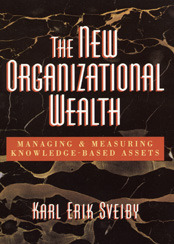The New Organizational Wealth
Managing and Measuring Knowledge-Based Assets
Karl Erik Sveiby (Author)
Publication date: 03/01/1997
Bestseller over 30,000+ copies sold
Shares in Microsoft, the world's largest computer software firm, changed hands at an average price of $70 during 1995, at a time when their "book value" or "equity" was just $7. In other words, for every $1 of tangible value, the market saw $9 of additional value, for which there was no corresponding record in Microsoft's balance sheet. This extra $9 in the value of Microsoft shares represents a major trend. More and more, companies are deriving value from their intangible assets. These assets include their employee's creative ideas, their customers' loyalty, their ability to attract and keep prestigious accounts, their innovative products and services, their popular brand names, and their reputation.
Knowledge-based organizations with intangible assets, such as accounting and legal firms, management consultants, advertising agencies, medical clinics and hospitals, software and engineering companies, and the art and entertainment industry make up the fastest growing business sector. Yet few of these companies achieve their potential performance and profitability because they do not know how to exploit their intangible assets. They measure performance only in terms of money, ignoring less tangible but vital assets such as the ability to capture high profile customers or the creativity to keep the company on the cutting edge with innovative products or services.
The New Organizational Wealth shows how some of the fastest-growing, most profitable companies are discovering that potentially limitless revenues can flow from their firm's intangible assets-the ability of employees, customers, and even suppliers to create new concepts, models, products, and services. Among the book's many examples is Netscape Communications. This successful company demonstrates the profitable results of fostering long-term customer relationships and the effectiveness of investing in employee competence to maintain a rich pool of talent.
The New Organizational Wealth outlines the conceptual framework for changing business strategies to focus on intangible assets. Using its guidelines, managers can learn how to identify the indicators for their company's intangible assets-their employee's talents and strengths, their customers' support and interest, and their supplier's reliability and ingenuity. Specific chapters detail how to effectively use and measure these "tacit" assets, as well as how to monitor them for financial success. Helpful case studies of Scandanavian companies such as WM-data-s, Skandia AFS, and Celemi, which have developed systems for measuring intangible assets and publicly reporting the results, provide models managers can use in leading their companies to increased profitability and long-term organizational success.
- The first book on managing and measuring intangible assets
- Shows how to tap customer and employee knowledge to build a more successful organization
- Provides tools for measuring such intangible assets as competent and creative employees, patents, brand names, or company reputation
- Written by an experienced manager who played a key role in developing the "Scandinavian Movement" of management
Find out more about our Bulk Buyer Program
- 10-49: 20% discount
- 50-99: 35% discount
- 100-999: 38% discount
- 1000-1999: 40% discount
- 2000+ Contact ( bookorders@bkpub.com )
Shares in Microsoft, the world's largest computer software firm, changed hands at an average price of $70 during 1995, at a time when their "book value" or "equity" was just $7. In other words, for every $1 of tangible value, the market saw $9 of additional value, for which there was no corresponding record in Microsoft's balance sheet. This extra $9 in the value of Microsoft shares represents a major trend. More and more, companies are deriving value from their intangible assets. These assets include their employee's creative ideas, their customers' loyalty, their ability to attract and keep prestigious accounts, their innovative products and services, their popular brand names, and their reputation.
Knowledge-based organizations with intangible assets, such as accounting and legal firms, management consultants, advertising agencies, medical clinics and hospitals, software and engineering companies, and the art and entertainment industry make up the fastest growing business sector. Yet few of these companies achieve their potential performance and profitability because they do not know how to exploit their intangible assets. They measure performance only in terms of money, ignoring less tangible but vital assets such as the ability to capture high profile customers or the creativity to keep the company on the cutting edge with innovative products or services.
The New Organizational Wealth shows how some of the fastest-growing, most profitable companies are discovering that potentially limitless revenues can flow from their firm's intangible assets-the ability of employees, customers, and even suppliers to create new concepts, models, products, and services. Among the book's many examples is Netscape Communications. This successful company demonstrates the profitable results of fostering long-term customer relationships and the effectiveness of investing in employee competence to maintain a rich pool of talent.
The New Organizational Wealth outlines the conceptual framework for changing business strategies to focus on intangible assets. Using its guidelines, managers can learn how to identify the indicators for their company's intangible assets-their employee's talents and strengths, their customers' support and interest, and their supplier's reliability and ingenuity. Specific chapters detail how to effectively use and measure these "tacit" assets, as well as how to monitor them for financial success. Helpful case studies of Scandanavian companies such as WM-data-s, Skandia AFS, and Celemi, which have developed systems for measuring intangible assets and publicly reporting the results, provide models managers can use in leading their companies to increased profitability and long-term organizational success.
- The first book on managing and measuring intangible assets
- Shows how to tap customer and employee knowledge to build a more successful organization
- Provides tools for measuring such intangible assets as competent and creative employees, patents, brand names, or company reputation
- Written by an experienced manager who played a key role in developing the "Scandinavian Movement" of management









